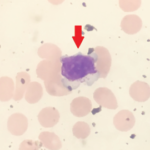Examining a complete blood count can offer assistance in diagnosis, said Dr. Miller. Neutropenia and lymphocytosis are atypical in children with rheumatic diseases. Because activated lymphocytes migrate out of circulation to target organs, lymphopenia is more common, such as in children with active systemic lupus erythematosus (SLE). Decreased counts in all cell lines raise the possibility of secondary macrophage activation syndrome, he noted.
Infections may precede arthralgias in children. “The differential diagnosis includes a transient, post-infectious arthritis typically lasting less than six weeks—although, I’ve seen it last as long as three months,” said Dr. Miller. Bacterial infections, such as enteritis and urinary tract infections, may trigger reactive arthritis, from which a small percentage of children will develop chronic arthritis.
Juvenile Arthritis
Often, rheumatologists use the 1997 classification criteria to diagnose children with JIA, a group of diseases that lasts for six weeks or longer in children ages 16 years or younger. These diseases include systemic JIA, oligoarthritis, polyarthritis, psoriatic arthritis, enthesitis-related arthritis (ERA) and undifferentiated arthritis.1
In systemic JIA, “there may be a delay before synovitis develops, often up to several months,” Dr. Miller said. Children with oligoarticular JIA may also have arthralgias for weeks or months before synovitis develops, as well as atrophy of extensor muscles. “These children may require splinting. This is a group in whom uveitis occurs—often asymptomatic,” he said.
Children with polyarticular JIA often have arthritis that affects the small joints in their hands and cervical spine, and typically have a chronic disease course. A subset of children with clinical oligoarticular arthritis exists, and these children have a more aggressive, chronic disease course, said Dr. Miller. “None of the JIA subtypes are homogenous. Children with JIA may need physical or occupational therapy and also splinting.”
Children with enthesitis may present with arthritis followed by enthesitis or pain over the attachment of tendons or ligaments to bone, such as over the Achilles tendons or plantar fasciae. Some children with other JIA subtypes can also present with enthesitis in addition to synovitis, Dr. Miller noted.
“It’s actually rare that we see advanced spine disease resulting in ankylosis in children with [enthesitis-related arthritis]. I’ve only seen this a couple of times in boys who were HLA-B27 positive,” said Dr. Miller. “Enthesitis may take months or even years to manifest.”
Magnetic resonance imaging (MRI) is an effective tool to detect joint erosions and bone marrow edema in children with enthesitis-related arthritis. And there may be a family history of the disease, he said.



